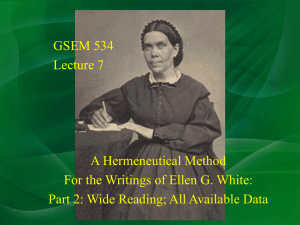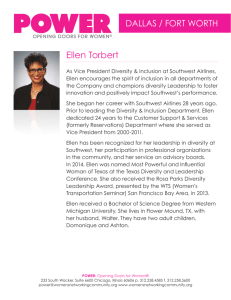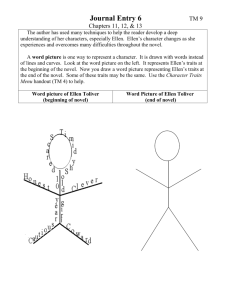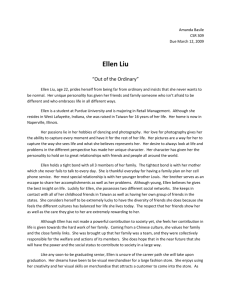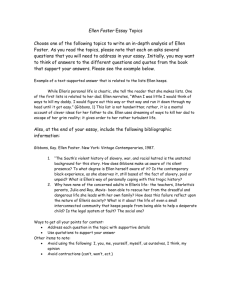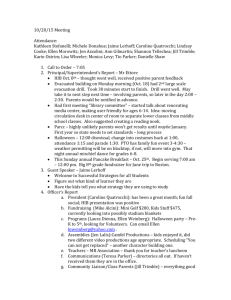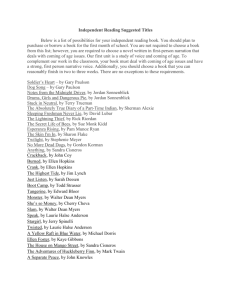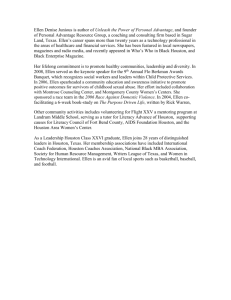Task Analysis Case Study
advertisement
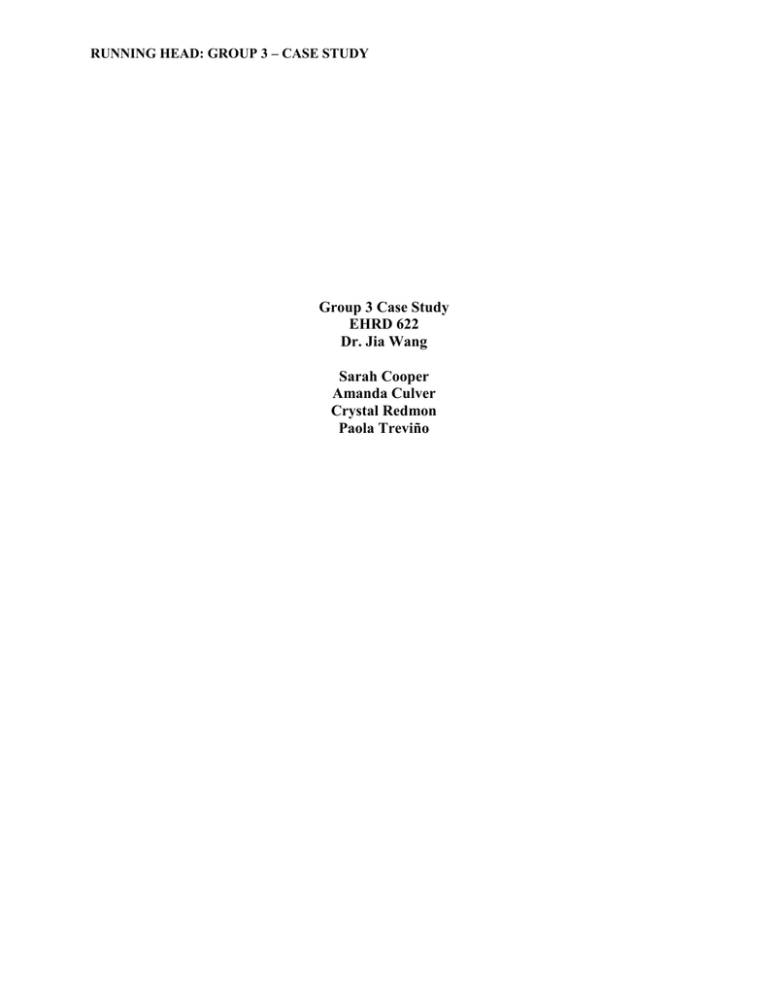
RUNNING HEAD: GROUP 3 – CASE STUDY Group 3 Case Study EHRD 622 Dr. Jia Wang Sarah Cooper Amanda Culver Crystal Redmon Paola Treviño GROUP 3- CASE STUDY 2 In general, what was Ellen’s approach to the needs assessment? Ellen’s approach to the needs assessment was fairly casual and informal. Ellen was approached by a co-worker who stated someone within the organization had requested additional training be given to employees in the accounting department. Once the request was made, Ellen set out to make her own conclusions on whether training was the appropriate next step. Ellen’s approach to the needs assessment was justified because she did not want to assume the person requesting the training already conducted the assessment. It is important before introducing training that a needs assessment is properly implemented (Barbazette, 2006). She knew a needs assessment would help specify the training need or performance deficiency that was present in the accounting department (Barbazette, 2006). According to the information provided in the case study, Ellen’s main focus was on the tasks. Ellen conducted a task analysis by creating a survey which was given to the senior accounting analyst. She also used the current job description to help decipher what is required of newly hired account analyst. Ellen’s main focus seemed to be on the task portion of the needs assessment. Although task analysis is an important part of a needs assessment, other areas of the organization must also be investigated. At face value, it may look as though the organization has one issue, but after completing a thorough needs assessment the organization might have other issues that are to blame (DeSimone & Werner, 2010). Ellen approached the needs assessment with a primary focus on the job/task. In doing so, she limited her ability to conduct a proper needs assessment. GROUP 3- CASE STUDY 3 What specific steps did she take? The first step Ellen took was collecting information on the current situation. Collecting data is an important part of conducting a needs assessment. Collecting data will help Ellen decide if there is a deficiency in performance (Barbazette, 2006). She collected information on current employees as well as the previous courses these employees completed in college. This helped Ellen assess what educational information the employees have had prior to their position at DrugCureAll (DCA). This will help Ellen build on the employee’s prior knowledge if in fact training is required in this case study. A thorough needs assessment should look at three different levels within the organization; task analysis, person analysis, and the organizational analysis (DeSimone & Werner 2010). In Ellen’s approach she first gathered information from the supervisors and accounting managers. The process of gathering information is an important step when conducting a training needs assessment. Not only did Ellen gather new information by interviewing upper management, but she also asked the accounting department for their current training literature. Gathering new data and existing data will help Ellen make appropriate decisions about the need for training and what abilities those needing training already possess (Barbazette, 2006). Ellen also requests a current job description for the accounting analyst position. The job description helps Ellen with the task analysis. The job description will help Ellen understand the activities involved in performing the job (DeSimone & Werner, 2010). This piece of information is a significant part of task analysis. Having no prior knowledge of how to conduct a task analysis, Ellen found an informal method online. She used this method to conduct the task analysis portion of the needs assessment. GROUP 3- CASE STUDY 4 Were these steps followed correctly or effectively? Much of the confusion about task analysis that frustrates inexperienced instructional developers results from a lack of agreement about what the process of task analysis involves. What exactly do designers do when they conduct a task analysis? That varies greatly among developers (Jonassen & Hannum, 1986). In Ellen’s attempt to complete a task analysis she effectively completed one of six steps as described by Jean Barbazette (2006). “Interviewing the boss/supervisor of the typical performer” is step 3; this step is used to validate the observations of the tasks being completed (Barbazette, 2006, p. 85). Supervisors are able to provide feedback on how the tasks should be completed, and how performance is evaluated. This is just one step in the process, since supervisors are not users of the task often times their views are skewed of how it can be completed. In Ellen’s topdown approach to producing a task inventory, she has used a combination of human resources and the supervisor’s job description to create a task analysis list. She will then distribute this to senior accounting analysts to complete a questionnaire about the tasks. This is a quick way to complete a needs assessment for the task inventory. Unfortunately, “observing the performer at work results in a much greater understanding of the task than does eliciting details through interviews” (Swanson, 2007, p. 148). For Ellen to use her analysis to create a training program it is key to create a thorough and complete task analysis or it could jeopardize the success of the entire program (Jonassen & Hannum, 1986). Were any steps missing? In Ellen’s attempt to complete a task analysis to be used in developing an instructional training program, she skipped several important steps – primarily involving observation and interaction with current account analysts. This first step in a task analysis, as described by GROUP 3- CASE STUDY 5 Barbazette (2006), is to observe a typical performer and record the steps/tasks they complete (p 84). This provides a more real-time analysis of the job duties than simply using the job description human resources provided. The official job description will not have details about the actual skills needed to complete the job, and may not be accurate about the current tasks assigned to the accounting analysts; it should be used as a resource for comparison and not the primary task list (Swanson, 2007). The second step is to interview a subject matter expert. This step is used to validate the task list created thus far and distinguishes easy steps from difficult steps (Barbazette, 2006). For Ellen, these subject matter experts are a good source to determine how training is currently rendered and determine any disparities they have seen in the process. Ellen did plan to give the senior accounting analysts surveys to determine the importance, frequency, and difficulty of tasks provided by the job description. However, she should first utilize these senior analysts to verify and supplement her task list, this will provide a more thorough and complete analysis overall. Additionally, by completing a comprehensive interview where senior analysts provide detailed information for how they have been able to succeed in the position, Ellen will gain insight into how these employees have been able to apply previously acquired knowledge to the task requirements of the analyst positions (Hoffman & Medsker, 1983). While Ellen did complete the third step in the process, as previously discussed, she missed the fourth step of using a task force to determine inconsistencies in the standardization of the task list (Barbazette, 2006). It is unclear from the information provided if the accounting department is housed solely at the corporate headquarters. Therefore, it is important for Ellen to determine if there are other accounting departments, and how the tasks lists differ for their GROUP 3- CASE STUDY 6 accounting analysts. If the performance issues are not occurring at the other locations, this can be analyzed to determine where the differences lie. The fifth step in Barbazette’s task analysis is brainstorm with the target population (Barbazette, 2006). This can be used to validate the information received from the supervisors and subject matter experts. If a supervisor and senior analyst see a task as simple to complete, but the analysts find it difficult this could be a workplace expertise issue. Since DCA has made the decision to develop expertise, by hiring accounting analysts with varying levels of accounting experience, it is important to analyze exactly what an analysts must know in order to meet the performance standard of each task (Swanson, 2007). The sixth and final step to provide a comprehensive task analysis is to do a final observation of accounting analysts completing the required tasks. This repetition of step one will validate the information obtained in steps two through five (Barbazette, 2006). Finally, if Ellen were to complete all six steps, she would be able to provide an accurate task analysis and a proposal to Pedro on the best ways to teach the tasks to account analysts in the New Accounting Analyst Training Program. Only by completing all of these steps will her analysis be comprehensive. As it currently stands, Ellen only has a job description from human resources and the potential feedback from subject matter experts in the form of a questionnaire. She does not have any interaction or observation of the task actually being performed and what is required to meet the performance requirements of the accounting analyst position. What sources/methods were used to collect information needed for needs assessment? Ellen used various methods for collecting data including interviews, reviewing notes from the HR Director Pedro, looking at the recruitment files of candidates, observing new hire orientations, and conducting a task analysis survey. Ellen’s method of using multiple collection GROUP 3- CASE STUDY 7 variables is a general requirement to gain the necessary information to conduct an effective needs assessment. According to Swanson (2007), “using multiple methods and multiple perspectives increases the validity of the assessment” (p. 108). Were these sources/methods for data collection effective? Taking Pedro’s notes and analyzing them was an effective start to benchmark the needs assessment. This gives Ellen a premise to work off, as well as determine the methods she would then use to conduct the assessment. Ellen’s interviewing method was effective and ineffective. “Interviews and focus groups provide open-ended information that enrich an assessment” (Phillips & Holton III, 1995, p. 5). The interviewing was effective because she interviewed the accounting managers and supervisors who have observed the limitations of the new hires. However, more could have been done in the interview process to make the data more effective. If Ellen were to have interviewed the new hires, and gained their perspective on the manner, she would then be able to compare the responses of both parties to conclude better results. Ellen’s next step was collecting file data on the new hires. She used this information to determine their skill-set, majors, and GPAs, to see if there was a pattern in the new hires. Since the company recruits and hires top candidates this was an effective method of assessment. This allowed Ellen to observe any potential gaps in the hiring process that could possibly be leading to the performance gap of the new employees. Observing a new hire orientation was a great assessment method for Ellen. This allowed her to witness part of the performance gap expressed by the supervisors not even addressed in the orientation. The managers expressed the new hires had a lack of understanding of the mission and values, and the organizational hierarchy. With her observation she was able to see these key gaps were not being addressed when a new hire came on board. GROUP 3- CASE STUDY 8 Lastly, a task analysis survey was developed and distributed to all senior accounting analysts. Ellen’s idea of collecting specific job information from the experts would allow her to develop a proper training. “Often task analysis is conducted to find the best method to complete a task or to force consistency in how a task is completed throughout an organization” (Barbazette, 2006, p.84). While this was a good idea, it would be more effective to conduct this survey with the new hires. This would allow her to see what the new hires believe their struggles are which would be more effective since they are the ones whose performance gaps are being addressed. If you were in Ellen’s position, what would you have done differently in conducting the needs assessment in this case? In reviewing the material presented by Ellen and the information she found our group believes she did well overall in her findings. We have found she primarily focused on the task portion of the needs assessment. If we were in Ellen’s position, our group would have conducted our study a bit differently only to improve the quality of work she already has. Receiving a more well-rounded aspect of the search would not only help her own study, but it would also complete the task she was presented with by Pedro, the HR director. When asked to conduct a thorough needs assessment of the new accounting analyst situation, Ellen could have completed her own goal for the issue at hand and made a checklist of the issues she should investigate. Although she did well in identifying the task analysis portion of this assessment there are other portions of the assessment should could have focused on to improve her study. We first start with reviewing the major steps Ellen took to conduct the needs assessment of the new accounting analyst. According to the case study, the first thing Ellen did was to “ask Pedro what Jill said about the new accounting hire’s strength and weaknesses”. Considering, she was asked GROUP 3- CASE STUDY 9 to conduct a needs assessment one of the first things to do is conduct a performance diagnosis and ask a number of valuable questions. Conducting a performance diagnosis can save the company from wasting valuable time and money, which can also save the analysis the time in performing unnecessary training for the employees. According to Swanson (2007) “Accurate performance diagnosis is the first step in improving performance” (p.50). From the information given, it is not that the accountants are incapable of performing the duties assigned, however “the new hire majors were all over the board along with the number of accounting and computer courses they had each taken”. Jill Styles, the accounting director, asked Pedro “Please create a training program to get our new accounting hires up to speed; we want them to hit the ground running and we need your help!” It is good to know Ms. Styles acknowledges there is a problem within the new hires; however a training program may not be the solution to the problem. Since most of the new hires range all over the board with certain courses they have taken, it would be more effective to conduct a research with each new hire to see in what area they may be lacking. Once the areas of discrepancy have been identified, instead of having all the new hires attend the newly created training course, Ellen can identify specific training courses the new hires can attend to improve their weaknesses. According to the case study, “Ellen then interviewed a few of the accounting managers and supervisors who sit next to her at DCA head-quarters. Ellen interviewed them one-on-one and recorded their comments”. From the results Ellen gathered, the managers spoke highly of their boss Jill Styles and agreed with the vision she has for the new hires. Ms. Styles has the support of her employees, which is great; however this does not really pertain to the new accounting hires and their lack of performance. If we were tasked with this assignment, we GROUP 3- CASE STUDY 10 would have conducted an interview with not only Ms. Styles and her managers but with the new hires. Through our research, our group has determined one of the best methods to conduct this interview would be in a focus group. Having all of the new hires in one interview allows them to feel more comfortable in sharing their own concerns. Receiving responses directly from those involved in the main issue lets Ellen document and research the doubts they have while performing their job duties. Most of these new hires are recent graduates and have little to no job experience. Asking the hires specific questions will explain the answer to the questions managers in the accounting department may have regarding new employees. Another major step Ellen took to conduct her needs analysis was to ask “the recruiter for a current job description of an accounting analyst position at DCA,” based on the information provided in the case study. By reviewing the job description of the new hire analyst, Ellen is able to pin point the specific activities new hires are supposed to be proficient in. Although we agree with Ellen in reviewing the job description, our group would have taken an extra step in the review process. We suggest Ellen research the new hire analysts and find out what areas they are deficient in. By first reviewing the job description and then interviewing the analyst and their managers, we can determine what skills the employees need. Ellen did well in researching the job description; however another suggestion proposed is to conduct an observation of the current account analyst. Reviewing a job description and finding out what skills and training is needed is essential, however to find out the actual skills involved in the position of an analyst by observing their day to day operations provides an in-depth look at their job. According to Swanson (2007), “Observing people at work requires considerable skill. Great sensitivity and the ability to be unobtrusive are essential. To avoid altering the work process, you must become part of the flow” (p.115). Observing the analyst, viewing duties GROUP 3- CASE STUDY 11 performed, and how they complete those duties will give Ellen a firsthand view. In the case study, the managers complained the new hire analysts “take longer than usual to get up to speed in their jobs and are lost when it comes to the organizational hierarchy”. Ellen can observe the current account analyst, take notes of how they do things, and possibly ask questions regarding why and how certain tasks are performed a certain way. Ellen can present her finding to Pedro and suggest they take a closer look at the steps taken from the current analyst and allow the new hires to learn from her findings. The new hires may simply be confused in the steps of certain duties and learning from a current analyst could help reduce the need for new training course. This is Ellen’s first time conducting a needs assessment and putting together a design and development effort. Considering this is Ellen’s first time being tasked with such a major project we believe she put in a lot of effort to gather the information and findings for this project. Our group has suggested a few things Ellen could have done otherwise only to help better the results overall. As with any other task being learned, practice makes perfect and with due time Ellen will be able to perfect her needs assessment skills to develop and organize a great report. GROUP 3- CASE STUDY 12 References Barbazette, J. (2006). Training needs assessment, methods, tools, and techniques. San Francisco, CA: Pfeiffer DeSimone, R. L. & Werner, J. M., (2012). Human resource development. (6th ed.). Mason, OH: South- Western Pub. Hoffman, C. K., & Medsker, K. L. (1983). Instructional analysis: the missing link between task analysis and objectives. Journal of Instructional Development, 6(4), 17-23. Jonassen, D. H., & Hannum, W. H. (1986). Analysis of task analysis procedures. Journal of Instructional Development, 9(2), 2-12. Phillips, J. & Holton III, E. (1995). In Action: conducting needs assessment. Alexandria, VA: American Society of Training and Development Swanson, R. (2007). Analysis for improving performance. (2nd ed.). San Francisco: BerrettKoehler Publishers, Inc.
